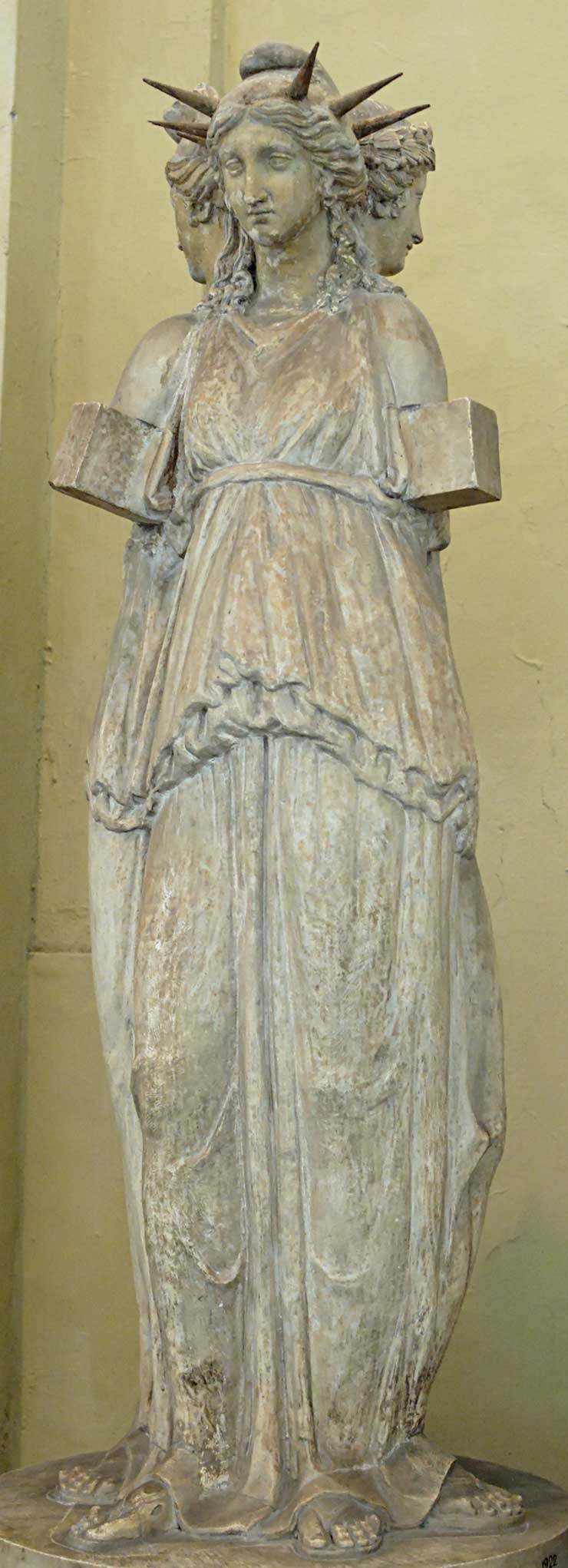

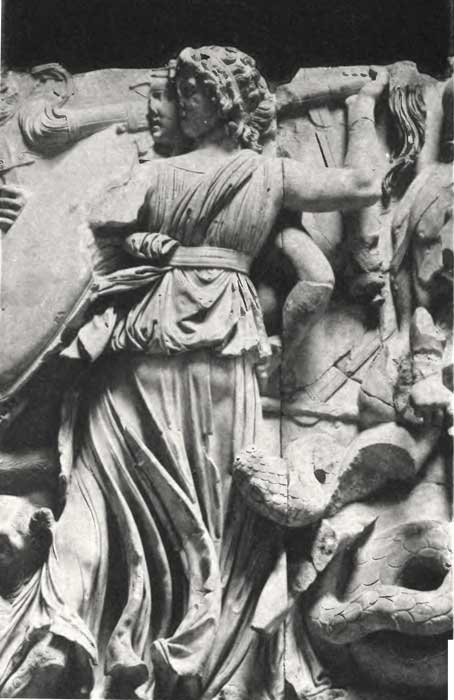

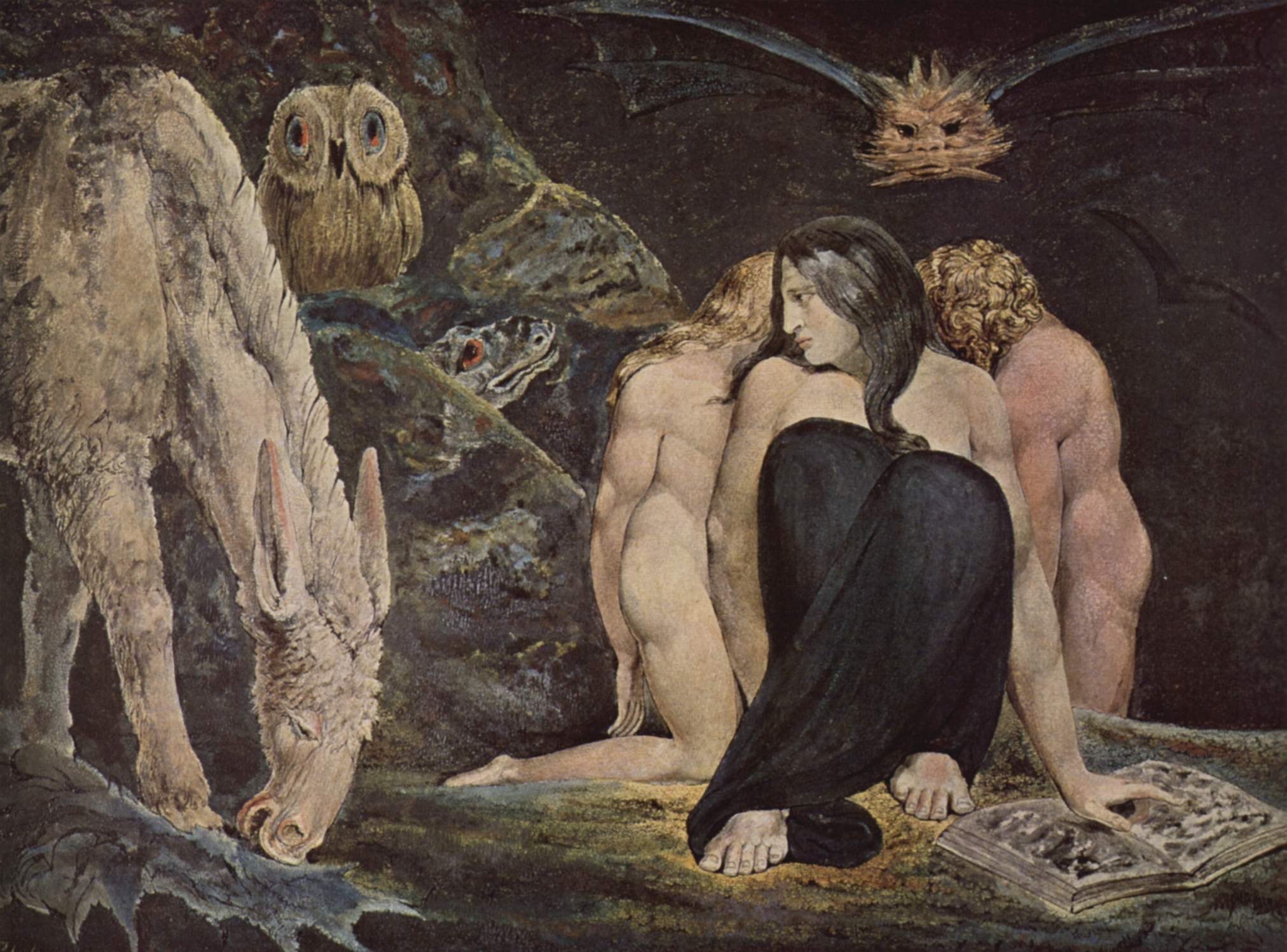
Hecate
| Hecate | |
|---|---|
 |
Hecate or Hekate (ancient Greek Ἑκάτη, Hekátē, pronounced /ˈhɛkətiː/ or /ˈhɛkət/[1] in English) is a chthonicGreco-Roman goddess associated with magic and crossroads.
She is attested in poetry as early as Hesiod's Theogony. An inscription from late archaic Miletus naming her as a protector of entrances is also testimony to her presence in archaic Greek religion.[2]
Regarding the nature of her cult, it has been remarked, "she is more at home on the fringes than in the center of Greek polytheism. Intrinsically ambivalent and polymorphous, she straddles conventional boundaries and eludes definition."[3] She has been associated with childbirth, nurturing the young, gates and walls, doorways, crossroads, magic, lunar lore, torches and dogs. William Berg observes, "Since children are not called after spooks, it is safe to assume that Carian theophoric names involving hekat- refer to a major deity free from the dark and unsavoury ties to the underworld and to witchcraft associated with the Hecate of classical Athens."[4]But he cautions, "The Laginetan goddess may have had a more infernal character than scholars have been willing to assume."[5] In Ptolemaic Alexandria and elsewhere during the Hellenistic period, she appears as a three-faced goddess associated with magic, witchcraft, and curses. Today she is claimed as a goddess ofwitches and in the context of Hellenic Polytheistic Reconstructionism. Some neo-pagans refer to her as a "crone goddess",[6] though this characterization appears to conflict with her frequent characterization as a virgin in late antiquity.[7] She closely parallels the Roman goddess Trivia.
Etymology, spelling, and pronunciation
Notable proposed etymologies for the name Hecate are:
- From the Greek word for 'will'.[8]
- From Greek Ἑκάτη [Hekátē], feminine equivalent of Εκατός Hekatos, obscure epithet of Apollo.[9] This has been translated as "her that operates from afar", "her that removes or drives off",[10] "the far reaching one" or "the far-darter".[11]
- From the Egyptian goddess of childbirth, Heqet.[12]
Arthur Golding's 1567 translation of Ovid's Metamorphoses refers to "triple Hecat"[13] and this spelling without the final E later appears in plays of the Elizabethan-Jacobean period.[14] Noah Webster in 1866 particularly credits the influence of Shakespeare for the then-predominant pronunciation of "Hecate" without the final E.[15]
[Representations
The earliest Greek depictions of Hecate are single faced, not triplicate. Lewis Richard Farnell states:
The evidence of the monuments as to the character and significance of Hecate is almost as full as that of the literature. But it is only in the later period that they come to express her manifold and mystic nature. Before the fifth century there is little doubt that she was usually represented as of single form like any other divinity, and it was thus that the Boeotian poet imagined her, as nothing in his verses contains any allusion to a triple formed goddess.[16]
The earliest known monument is a small terracotta found in Athens, with a dedication to Hecate, in writing of the style of the 6th century. The goddess is seated on a throne with a chaplet bound round her head; she is altogether without attributes and character, and the only value of this work, which is evidently of quite a general type and gets a special reference and name merely from the inscription, is that it proves the single shape to be her earlier form, and her recognition at Athens to be earlier than the Persian invasion.[17]
| Chthonic deities | |
The 2nd-century traveller Pausanias stated that Hecate was first depicted in triplicate by the sculptor Alkamenes in the Greek Classical period of the late 5th century. Greek anthropomorphic conventions of art resisted representing her with three faces: a votive sculpture from Attica of the 3rd century BCE (illustration, left), shows three single images against a column; round the column of Hecate dance the Charites. Some classical portrayals show her as a triplicate goddess holding a torch, a key, and a serpent. Others continue to depict her in singular form.
In Egyptian-inspired Greek esoteric writings connected with Hermes Trismegistus, and in magical papyri of Late Antiquity she is described as having three heads: one dog, one serpent, and one horse. In other representations her animal heads include those of a cow and a boar.[18] Hecate's triplicity is elsewhere expressed in a more Hellenic fashion in the vast frieze of the great Pergamon Altar, now in Berlin, wherein she is shown with three bodies, taking part in the battle with the Titans. In the Argolid, near the shrine of the Dioscuri, Pausanias saw the temple of Hecate opposite the sanctuary of Eileithyia; He reported the image to be the work of Scopas, stating further, "This one is of stone, while the bronze images opposite, also of Hecate, were made respectively by Polycleitus and his brother Naucydes, son of Mothon." (Description of Greece 2.22.7)
A 4th century BCE marble relief from Crannon in Thessaly was dedicated by a race-horse owner.[19] It shows Hecate, with a hound beside her, placing a wreath on the head of a mare. She is commonly attended by a dog or dogs, and the most common form of offering was to leave meat at a crossroads. Sometimes dogs themselves were sacrificed to her. This is sometimes offered as an indication of her non-Hellenic origin, as dogs very rarely played this role in genuine Greek ritual.[20]
In the Argonautica, a 3rd century BCE Alexandrian epic based on early material,[21] Jason placates Hecate in a ritual prescribed by Medea, her priestess: bathed at midnight in a stream of flowing water, and dressed in dark robes, Jason is to dig a round pit and over it cut the throat of a ewe, sacrificing it and then burning it whole on a pyre next to the pit as a holocaust. He is told to sweeten the offering with a libation of honey, then to retreat from the site without looking back, even if he hears the sound of footsteps or barking dogs.[22] All these elements betoken the rites owed to a chthonic deity.
[]Mythology
Hecate has been characterized as a pre-Olympian chthonic goddess. She appears in the Homeric Hymn to Demeter and in Hesiod's Theogony, where she is promoted strongly as a great goddess. The place of origin of her following is uncertain, but it is thought that she had popular followings in Thrace.[23] Her most important sanctuary was Lagina, a theocratic city-state in which the goddess was served by eunuchs.[23] Lagina, where the famous temple of Hecate drew great festal assemblies every year, lay close to the originally Macedonian colony of Stratonikeia, where she was the city's patroness.[24] In Thrace she played a role similar to that of lesser-Hermes, namely a governess of liminal regions (particularly gates) and the wilderness, bearing little resemblance to the night-walking crone she became. Additionally, this led to her role of aiding women in childbirth and the raising of young men.[citation needed]
Hesiod records that she was esteemed as the offspring of Gaia and Uranus, the Earth and Sky. In Theogony he ascribed great powers to Hecate:
[...] Hecate whom Zeus the son of Cronos honored above all. He gave her splendid gifts, to have a share of the earth and the unfruitful sea. She received honor also in starry heaven, and is honored exceedingly by the deathless gods. For to this day, whenever any one of men on earth offers rich sacrifices and prays for favor according to custom, he calls upon Hecate. Great honor comes full easily to him whose prayers the goddess receives favorably, and she bestows wealth upon him; for the power surely is with her. For as many as were born of Earth and Ocean amongst all these she has her due portion. The son of Cronos did her no wrong nor took anything away of all that was her portion among the former Titan gods: but she holds, as the division was at the first from the beginning, privilege both in earth, and in heaven, and in sea.[25]
According to Hesiod, she held sway over many things:
Whom she will she greatly aids and advances: she sits by worshipful kings in judgement, and in the assembly whom she will is distinguished among the people. And when men arm themselves for the battle that destroys men, then the goddess is at hand to give victory and grant glory readily to whom she will. Good is she also when men contend at the games, for there too the goddess is with them and profits them: and he who by might and strength gets the victory wins the rich prize easily with joy, and brings glory to his parents. And she is good to stand by horsemen, whom she will: and to those whose business is in the grey discomfortable sea, and who pray to Hecate and the loud-crashing Earth-Shaker, easily the glorious goddess gives great catch, and easily she takes it away as soon as seen, if so she will. She is good in the byre with Hermes to increase the stock. The droves of kine and wide herds of goats and flocks of fleecy sheep, if she will, she increases from a few, or makes many to be less. So, then, albeit her mother's only child, she is honored amongst all the deathless gods. And the son of Cronos made her a nurse of the young who after that day saw with their eyes the light of all-seeing Dawn. So from the beginning she is a nurse of the young, and these are her honors.[25]
Hesiod emphasizes that Hecate was an only child, the daughter of Perses and Asteria, a star-goddess who was the sister of Leto (the mother of Artemisand Apollo). Grandmother of the three cousins was Phoebe the ancient Titaness who personified the moon.
Hesiod's inclusion and praise of Hecate in the Theogony has been troublesome for scholars, in that he seems to hold her in high regard, while the testimony of other writers, and surviving evidence, suggests that this was probably somewhat exceptional. It is theorized that Hesiod's original village had a substantial Hecate following and that his inclusion of her in the Theogony was a way of adding to her prestige by spreading word of her among his readers.[26]
Hecate possibly originated among the Carians of Anatolia,[23] the region where most theophoric names invoking Hecate, such as Hecataeus or Hecatomnus, the father of Mausolus, are attested,[27] and where Hecate remained a Great Goddess into historical times, at her unrivalled[28] cult site inLagina. While many researchers favor the idea that she has Anatolian origins, it has been argued that "Hecate must have been a Greek goddess."[29] The monuments to Hecate in Phrygia and Caria are numerous but of late date.[30]
If Hecate's cult spread from Anatolia into Greece, it is possible it presented a conflict, as her role was already filled by other more prominent deities in the Greek pantheon, above all by Artemis and Selene. This line of reasoning lies behind the widely accepted hypothesis that she was a foreign deity who was incorporated into the Greek pantheon. Other than in the Theogony, the Greek sources do not offer a consistent story of her parentage, or of her relations in the Greek pantheon: sometimes Hecate is related as a Titaness, and a mighty helper and protector of humans. Her continued presence was explained by asserting that, because she was the only Titan who aided Zeus in the battle of gods and Titans, she was not banished into the underworld realms after their defeat by the Olympians.[citation needed]
One surviving group of stories suggests how Hecate might have come to be incorporated into the Greek pantheon without affecting the privileged position of Artemis.[26] Here, Hecate is a mortal priestess often associated with Iphigeneia. She scorns and insults Artemis, who in retribution eventually brings about the mortal's suicide. Artemis then adorns the dead body with jewelry and commands the spirit to rise and become her Hecate, who subsequently performs a role similar to Nemesis as an avenging spirit, but solely for injured women. Such myths in which a native deity 'sponsors' or ‘creates’ a foreign one were widespread in ancient cultures as a way of integrating foreign cults. If this interpretation is correct, as Hecate's cult grew, she was inserted into the later myth of the birth of Zeus as one of the midwives that hid the child,[26] while Cronus consumed the deceiving rock handed to him by Rhea. There was an area sacred to Hecate in the precincts of the Temple of Artemis at Ephesus, where the priests, megabyzi, officiated.[31]
Hecate also came to be associated with ghosts, infernal spirits, the dead and sorcery. Like the totems of Hermes—herms placed at borders as a ward against danger—images of Hecate (like Artemis and Diana, often referred to as a "liminal" goddess) were also placed at the gates of cities, and eventually domestic doorways. Over time, the association with keeping out evil spirits could have led to the belief that if offended, Hecate could also allow the evil spirits in. According to one view, this accounts for invocations to Hecate as the supreme governess of the borders between the normal world and the spirit world, and hence as one with mastery over spirits of the dead.[26] Whatever the reasons, Hecate's power certainly came to be closely associated with sorcery. One interesting passage exists suggesting that the word "jinx" might have originated in a cult object associated with Hecate. "The Byzantine polymath Michael Psellus [...] speaks of a bullroarer, consisting of a golden sphere, decorated throughout with symbols and whirled on an oxhide thong. He adds that such an instrument is called a iunx (hence "jinx"), but as for the significance says only that it is ineffable and that the ritual is sacred to Hecate."[32]
Hecate is one of the most important figures in the so-called Chaldaean Oracles (2nd-3rd century CE),[33] where she is associated in fragment 194 with astrophalos (usually translated as a spinning top, or wheel, used in magic) "Labour thou around the Strophalos of Hecate."[34] This appears to refer to a variant of the device mentioned by Psellus.[35]
Variations in interpretations of Hecate's role or roles can be traced in 5th-century Athens. In two fragments of Aeschylus she appears as a great goddess. In Sophocles and Euripides she is characterized as the mistress of witchcraft and the Keres.
In the Homeric Hymn to Demeter, Hecate is called the "tender-hearted", a euphemism perhaps intended to emphasize her concern with the disappearance of Persephone, when she addressed Demeter with sweet words at a time when the goddess was distressed. She later became Persephone's minister and close companion in the Underworld. But Hecate was never fully incorporated among the Olympian deities.
The modern understanding of Hecate has been strongly influenced by syncretic Hellenistic interpretations. Many of the attributes she was assigned in this period appear to have an older basis. For example, in the magical papyri of Ptolemaic Egypt, she is called the 'she-dog' or 'bitch', and her presence is signified by the barking of dogs. In late imagery she also has two ghostly dogs as servants by her side. However, her association with dogs predates the conquests of Alexander the Great and the emergence of the Hellenistic world. When Philip II laid siege to Byzantium she had already been associated with dogs for some time; the light in the sky and the barking of dogs that warned the citizens of a night time attack, saving the city, were attributed to Hecate Lampadephoros (the tale is preserved in the Suda). In gratitude the Byzantines erected a statue in her honor.[36]
As a virgin goddess, she remained unmarried and had no regular consort, though some traditions named her as the mother of Scylla.[37]
[]Other names and epithets
- Apotropaia (that turns away/protects)[38]
- Chthonia (of the earth/underworld)[39]
- Enodia (on the way)[40]
- Klêidouchos (holding the keys)[41]
- Kourotrophos (nurse of children)[41]
- Phosphoros (bringing or giving light)[41]
- Propolos (who serves/attends)[41]
- Propulaia/Propylaia (before the gate)[42]
- Soteira (savior)[43]
- Trimorphe (three-formed)[41]
- Triodia/Trioditis (who frequents crossroads)[41]
[]Goddess of the crossroads
Cult images and altars of Hecate in her triplicate or trimorphic form were placed at crossroads (though they also appeared before private homes and in front of city gates).[44] In this form she came to be known as the goddess Trivia "the three ways" in Roman mythology. In what appears to be a 7th century indication of the survival of cult practices of this general sort, Saint Eligius, in his Sermo warns the sick among his recently converted flock in Flanders against putting "devilish charms at springs or trees or crossroads",[45] and, according to Saint Ouen would urge them "No Christian should make or render any devotion to the deities of the trivium, where three roads meet...".[46]
[]Animals
Dogs were closely associated with Hecate in the Classical world. "In art and in literature Hecate is constantly represented as dog-shaped or as accompanied by a dog. Her approach was heralded by the howling of a dog. The dog was Hecate's regular sacrificial animal, and was often eaten in solemn sacrament."[47] The sacrifice of dogs to Hecate is attested for Thrace, Samothrace, Colophon, and Athens.[48]
It has been claimed that her association with dogs is "suggestive of her connection with birth, for the dog was sacred to Eileithyia, Genetyllis, and other birth goddesses. Although in later times Hecate's dog came to be thought of as a manifestation of restless souls or demons who accompanied her, its docile appearance and its accompaniment of a Hecate who looks completely friendly in many pieces of ancient art suggests that its original signification was positive and thus likelier to have arisen from the dog's connection with birth than the dog's demonic associations."[49]
Athenaeus (writing in the 1st or 2nd century BCE, and drawing on the etymological speculation ofApollodorus) notes that the red mullet is sacred to Hecate, "on account of the resemblance of their names; for that the goddess is trimorphos, of a triple form". The Greek word for mullet was trigle and later trigla. He goes on to quote a fragment of verse "O mistress Hecate, Trioditis / With three forms and three faces / Propitiated with mullets".[50] In relation to Greek concepts of pollution, Parker observes, "The fish that was most commonly banned was the red mullet (trigle), which fits neatly into the pattern. It 'delighted in polluted things,' and 'would eat the corpse of a fish or a man'. Blood-coloured itself, it was sacred to the blood-eating goddess Hecate. It seems a symbolic summation of all the negative characteristics of the creatures of the deep."[51] At Athens, it is said there stood a statue of Hecate Triglathena, to whom the red mullet was offered in sacrifice.[52] After mentioning that this fish was sacred to Hecate, Alan Davidson writes, "Cicero, Horace, Juvenal, Martial, Pliny, Seneca and Suetonius have left abundant and interesting testimony to the red mullet fever which began to affect wealthy Romans during the last years of the Republic and really gripped them in the early Empire. The main symptoms were a preoccupation with size, the consequent rise to absurd heights of the prices of large specimens, a habit of keeping red mullet in captivity, and the enjoyment of the highly specialized aesthetic experience induced by watching the color of the dying fish change." [53]
The frog, significantly a creature that can cross between two elements, also is sacred to Hecate.[54]
In her three-headed representations, discussed above, Hecate often has one or more animal heads, including cow, dog, boar, serpent and horse.[55]
[]Plants
Hecate was closely associated with plant lore and the concoction of medicines and poisons. In particular she was thought to give instruction in these closely related arts. Apollonius of Rhodes, in the Argonautica mentions that Medea was taught by Hecate, "I have mentioned to you before a certain young girl whom Hecate, daughter of Perses, has taught to work in drugs."[56]
The goddess is described as wearing oak in fragments of Sophocles' lost play The Root Diggers (or The Root Cutters), and an ancient commentary on Apollonius of Rhodes' Argonautica (3.1214) describes her as having a head surrounded by serpents, twining through branches of oak.[57]
The yew in particular was sacred to Hecate.
"Greeks held the yew to be sacred to Hecate, queen of the underworld, crone aspect of the Triple Goddess. Her attendants draped wreathes of yew around the necks of black bulls which they slaughtered in her honor and yew boughs were burned on funeral pyres. The yew was associated with the alphabet and the scientific name for yew today, taxus, was probably derived from the Greek word for yew, toxos, which is hauntingly similar to toxon, their word for bow and toxicon, their word for poison. It is presumed that the latter were named after the tree because of its superiority for both bows and poison."[58]
Hecate was said to favor offerings of garlic, which was closely associated with her cult.[59] She is also sometimes associated with cypress, a tree symbolic of death and the underworld, and hence sacred to a number of chthonic deities.[60]
A number of other plants (often poisonous, medicinal and/or psychoactive) are associated with Hecate.[61] These include aconite (also called hecateis),[62]belladonna, dittany, and mandrake. It has been suggested that the use of dogs for digging up mandrake is further corroboration of the association of this plant with Hecate; indeed, since at least as early as the 1st century CE, there are a number of attestations to the apparently widespread practice of using dogs to dig up plants associated with magic.[63]
[]Places
Hecate was associated with borders, city walls, doorways, crossroads and, by extension, with realms outside or beyond the world of the living. She appears to have been particularly associated with being 'between' and hence is frequently characterized as a "liminal" goddess. "Hecate mediated between regimes – Olympian and Titan - but also between mortal and divine spheres."[64] This liminal role is reflected in a number of her cult titles: Apotropaia (that turns away/protects); Enodia (on the way); Propulaia/Propylaia (before the gate); Triodia/Trioditis (who frequents crossroads); Klêidouchos (holding the keys), etc.
As a goddess expected to avert demons from the house or city over which she stood guard and to protect the individual as she or he passed through dangerous liminal places, Hecate would naturally become known as a goddess who could also refuse to avert the demons, or even drive them on against unfortunate individuals.[65]
It was probably her role as guardian of entrances that led to Hecate's identification by the mid fifth century with Enodia, a Thessaliangoddess. Enodia's very name ("In-the-Road") suggests that she watched over entrances, for it expresses both the possibility that she stood on the main road into a city, keeping an eye on all who entered, and in the road in front of private houses, protecting their inhabitants.[66]
This function would appear to have some relationship with the iconographic association of Hecate with keys, and might also relate to her appearance with two torches, which when positioned on either side of a gate or door illuminated the immediate area and allowed visitors to be identified. "In Byzantium small temples in her honor were placed close to the gates of the city. Hecate's importance to Byzantium was above all as a deity of protection. When Philip of Macedon was about to attack the city, according to the legend she alerted the townspeople with her ever present torches, and with her pack of dogs, which served as her constant companions."[67] This suggests that Hecate's close association with dogs derived in part from the use of watchdogs, who, particularly at night, raised an alarm when intruders approached. Watchdogs were used extensively by Greeks and Romans.[68]
Like Hecate, "[t]he dog is a creature of the threshold, the guardian of doors and portals, and so it is appropriately associated with the frontier between life and death, and with demons and ghosts which move across the frontier. The yawning gates of Hades were guarded by the monstrous watchdog Cerberus, whose function was to prevent the living from entering the underworld, and the dead from leaving it."[69]
[]Festivals
Hecate was worshipped by both the Greeks and the Romans who had their own festivals dedicated to her. According to Ruickbie (2004, p. 19) the Greeks observed two days sacred to Hecate, one on the 13th of August and one on the 30th of November, whilst the Romans observed the 29th of every month as her sacred day.
[]Survival in pre-modern folklore
Hecate has survived in folklore as a 'hag' figure associated with witchcraft. Strmiska notes that Hecate, conflated with the figure of Diana, appears in late antiquity and in the early medieval period as part of an "emerging legend complex" associated with gatherings of women, the moon, and witchcraft that eventually became established "in the area of Northern Italy, southern Germany, and the western Balkans."[70] This theory of the Roman origins of many European folk traditions related to Diana or Hecate was explicitly advanced at least as early as 1807[71] and is reflected in numerous etymological claims by lexicographers from the 17th to the 19th century, deriving "hag" and/or "hex" from Hecate by way of haegtesse (Anglo-Saxon) and hagazussa (Old High German).[72] Such derivations are today proposed only by a minority[73] since being refuted by Grimm, who was skeptical of theories proposing non-Germanic origins for German folklore traditions.[74]
Modern etymology reconstructs Proto-Germanic *hagatusjon- from haegtesse and hagazussa;[75] the first element is probably cognate with hedge, which derives from PIE *kagh- "hedge, enclosure",[76] and the second perhaps from *dhewes- "fly about, be smoke, vanish."[75]
Whatever the precise nature of Hecate's transition into folklore in late Antiquity, she is now firmly established as a figure in Neopaganism,[77] which draws heavily on folkloric traditions[78] associating Hecate with 'The Wild Hunt',[79] witches, hedges and 'hedge-riding',[80] and other themes that parallel, but are not explicitly attested in, Classical sources.
[]Cross-cultural parallels
'I am she that is the natural mother of all things, mistress and governess of all the elements, the initial progeny of worlds, chief of powers divine, Queen of heaven, the principal of the Gods celestial, the light of the goddesses: at my will the planets of the air, the wholesome winds of the Seas, and the silences of hell be disposed; my name, my divinity is adored throughout all the world in divers manners, in variable customs and in many names, [...] Some call me Juno, others Bellona of the Battles, and still others Hecate. Principally the Ethiopians which dwell in the Orient, and the Egyptians which are excellent in all kind of ancient doctrine, and by their proper ceremonies accustomed to worship me, do call me Queen Isis.[...]'[81]The figure of Hecate can often be associated with the figure of Isis in Egyptian myth. Lucius Apuleius (c. 123—c. 170 CE) in his work "The Golden Ass" associates Hecate with Isis:
In the syncretism during Late Antiquity of Hellenistic and late Babylonian ("Chaldean") elements, Hecate was identified with Ereshkigal, the underworld counterpart of Inanna in the Babylonian cosmography. In the Michigan magical papyrus (inv. 7), dated to the late 3rd or early 4th century CE, Hecate Ereschigal is invoked against fear of punishment in the afterlife.[82]
Before she became associated with Greek mythology, she had many similarities with Artemis (wilderness, and watching over wedding ceremonies)[83]
[]In later Greek mythology, Hecate (or Hekate; Greek Ἑκάτη , Εκάτη , Hekátē) was scarcely more than the goddess of witchcraft and sorcery. She was not usually portrayed at all, though she was described as having three heads: one dog, one serpent and one horse. She had a special role at three-way crossroads, where the Greeks set poles with masks of each of her heads facing different directions: Roman mythology also saw her as the goddess of the Trivia "the three ways", a folk belief, whether Celtic or Roman, that survived into the 7th century AD among the pagans of Flanders. There Eligius was wont to remind his recently converted flock "No Christian should make or render any devotion to the gods of the trivium, where three roads meet, to the fanes or the rocks, or springs or groves or corners" (for details, see Druidry).
Mythology
Hekate was never incorporated among the Olympian gods. She remained a goddess of women's religion, a help in childbirth. In late imagery she also has two ghostly dogs as servants by her side. In the magical papyri of Ptolemaic Egypt, she is called the Bitch and the She-Wolf, and her presence is signified by the barking of dogs.
A version of Hecate has been appropriated by Wicca and other modern magic-practising religions.
In the earliest records of her, Hecate bears little resemblance to the night-walking crone. Hesiod records that she was among the offspring of Gaia and Uranus, the Earth and Sky. In Theogony he ascribed to Hecate such wide-ranging and fundamental powers, that it is hard to resist seeing such a deity as a figuration of the Great Goddess, though as a good Olympian Hesiod ascribes her powers as the "gift" of Zeus:
"Hecate whom Zeus the son of Cronos honoured above all. He gave her splendid gifts, to have a share of the earth and the unfruitful sea. She received honour also in starry heaven, and is honoured exceedingly by the deathless gods.... The son of Cronos did her no wrong nor took anything away of all that was her portion among the former Titan gods: but she holds, as the division was at the first from the beginning, privilege both in earth, and in heaven, and in sea".
Her gifts towards mankind are all-encompassing, Hesiod tells:
"Whom she will she greatly aids and advances: she sits by worshipful kings in judgement, and in the assembly whom she will is distinguished among the people. And when men arm themselves for the battle that destroys men, then the goddess is at hand to give victory and grant glory readily to whom she will. Good is she also when men contend at the games, for there too the goddess is with them and profits them: and he who by might and strength gets the victory wins the rich prize easily with joy, and brings glory to his parents. And she is good to stand by horsemen, whom she will: and to those whose business is in the grey discomfortable sea, and who pray to Hecate and the loud-crashing Earth-Shaker, easily the glorious goddess gives great catch, and easily she takes it away as soon as seen, if so she will. She is good in the byre with Hermes to increase the stock. The droves of kine and wide herds of goats and flocks of fleecy sheep, if she will, she increases from a few, or makes many to be less".
Hecate was carefully attended:
"For to this day, whenever any one of men on earth offers rich sacrifices and prays for favour according to custom, he calls upon Hecate. Great honour comes full easily to him whose prayers the goddess receives favourably, and she bestows wealth upon him; for the power surely is with her".
Hesiod emphasizes that Hecate was an only child, the daughter of Asteria, a star-goddess who was the sister of Leto, (the mother of Artemis and Apollo). Grandmother of the three cousins was Phoebe the ancient Titaness who personified the moon. Hecate was a reappearance of Phoebe, a moon goddess herself, who appeared in the dark of the moon.
Her power resembles that of sorcery, for Medea, who was a priestess of Hecate, used witchcraft, apparently under the guidance of the goddess, in order to handle magic herbs and poisons with skill, and to be able to stay the course of rivers, or check the paths of the stars and the moon.
Yet Hecate has been called tender-hearted, probably because she was concerned with the disappearance of Persephone, and addressed Demeter with sweet words when the goddess was distressed.
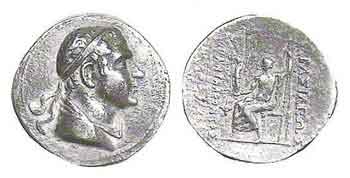
Silver tetradrachm of Pantaleon. [Source]
Obv: Bust of king Pantaleon with diadem.
Rev: Zeus seated on a throne, with scepter in left hand and, on extended right hand, a statue of Hecate holding two torches.
Symbols
In modern days, Wiccan followers of Hecate associate several symbols and objects with her.
Objects
Wicca represents Hecate as carrying torches, very often has a knife, and may appear holding a rope, a key, a phial, flowers or a pomegranate. The Greek cross is also a symbol of Hecate at the crossroads.
The torch is obviously a symbol of the light that illuminates the darkness. Her knife represents her role as midwife in cutting the umbilical cord (possibly symbolized by the rope), as well as severing the link between the body and spirit at death, and may be the origin of the athame of Wicca. The Key is significant to the Mysteries, as is the pomegranate, the fruit of the Underworld eaten by Persephone, which bound her to Hades.
Animals
In wicca, all wild animals are sacred to Hecate. Creatures of darkness, such as ravens, owls, snakes and dragons, are most sacred to her. Several images of Hecate show her holding a snake. Snakes have long been connected with chthonic powers and the uncommon wisdom of the Other world. The dog isthe animal most commonly associated with Hecate. She was sometimes called the 'Black she dog' and black dogs were once sacrificed to her in purification rituals. At Colophon in Thrace, Hecate might be manifest as a dog. The sound of barking dogs was the first sign of her approach in Greek and Roman literature. The frog, significantly a creature that can cross between two elements, is also sacred to Hecate and the Egyptian goddess Hekat. A triple goddess, she sometimes appears three headed as dog, horse and bear or dog, snake and lion.
Plants and herbs
The yew, cypress, hazel, black poplar and willow are all sacred to Hecate. The leaves of the black poplar are dark on one side and light on the other, symbolizing the boundary between the worlds. The yew has long been associated with the Underworld.
The yew has strong associations with death as well as rebirth. A poison prepared from the seeds was used on arrows, and yew wood was commonly used to make bows and dagger hilts. The potion in Hecate's cauldron contains 'slips of yew'. Yew berries carry Hecate's power, and can bring wisdom or death. The seeds are highly poisonous, but the fleshy, coral-colored 'berry' surrounding it is not. If prepared correctly, the berry can cause visual hallucinations.
Many other herbs and plants are associated with Hecate, including garlic, almonds, lavender, myrrh, mugwort, cardamon, mint, dandelion, hellebore, and lesser celandine. Several poisons and hallucinogens are linked to Hecate, including belladonna, hemlock, mandrake, aconite (known as hecateis), and opium poppy.
Festivals
Hecate was worshipped by both the Greeks and the Romans who had their own festivals dedicated to her. According to Ruickbie (2004:19) the Greeks observed two sacred days, one on the 13th of August and one on the 30th of November, whilst the Romans observed the 29th of every month as her sacred day.
In later Greek mythology, Hecate (or Hekate; Greek Ἑκάτη , Εκάτη , Hekátē) was scarcely more than the goddess of witchcraft and sorcery. She was not usually portrayed at all, though she was described as having three heads: one dog, one serpent and one horse. She had a special role at three-way crossroads, where the Greeks set poles with masks of each of her heads facing different directions: Roman mythology also saw her as the goddess of the Trivia "the three ways", a folk belief, whether Celtic or Roman, that survived into the 7th century AD among the pagans of Flanders. There Eligius was wont to remind his recently converted flock "No Christian should make or render any devotion to the gods of the trivium, where three roads meet, to the fanes or the rocks, or springs or groves or corners" (for details, see Druidry).
Mythology
Hekate was never incorporated among the Olympian gods. She remained a goddess of women's religion, a help in childbirth. In late imagery she also has two ghostly dogs as servants by her side. In the magical papyri of Ptolemaic Egypt, she is called the Bitch and the She-Wolf, and her presence is signified by the barking of dogs.
A version of Hecate has been appropriated by Wicca and other modern magic-practising religions.
In the earliest records of her, Hecate bears little resemblance to the night-walking crone. Hesiod records that she was among the offspring of Gaia and Uranus, the Earth and Sky. In Theogony he ascribed to Hecate such wide-ranging and fundamental powers, that it is hard to resist seeing such a deity as a figuration of the Great Goddess, though as a good Olympian Hesiod ascribes her powers as the "gift" of Zeus:
"Hecate whom Zeus the son of Cronos honoured above all. He gave her splendid gifts, to have a share of the earth and the unfruitful sea. She received honour also in starry heaven, and is honoured exceedingly by the deathless gods.... The son of Cronos did her no wrong nor took anything away of all that was her portion among the former Titan gods: but she holds, as the division was at the first from the beginning, privilege both in earth, and in heaven, and in sea".
Her gifts towards mankind are all-encompassing, Hesiod tells:
"Whom she will she greatly aids and advances: she sits by worshipful kings in judgement, and in the assembly whom she will is distinguished among the people. And when men arm themselves for the battle that destroys men, then the goddess is at hand to give victory and grant glory readily to whom she will. Good is she also when men contend at the games, for there too the goddess is with them and profits them: and he who by might and strength gets the victory wins the rich prize easily with joy, and brings glory to his parents. And she is good to stand by horsemen, whom she will: and to those whose business is in the grey discomfortable sea, and who pray to Hecate and the loud-crashing Earth-Shaker, easily the glorious goddess gives great catch, and easily she takes it away as soon as seen, if so she will. She is good in the byre with Hermes to increase the stock. The droves of kine and wide herds of goats and flocks of fleecy sheep, if she will, she increases from a few, or makes many to be less".
Hecate was carefully attended:
"For to this day, whenever any one of men on earth offers rich sacrifices and prays for favour according to custom, he calls upon Hecate. Great honour comes full easily to him whose prayers the goddess receives favourably, and she bestows wealth upon him; for the power surely is with her".
Hesiod emphasizes that Hecate was an only child, the daughter of Asteria, a star-goddess who was the sister of Leto, (the mother of Artemis and Apollo). Grandmother of the three cousins was Phoebe the ancient Titaness who personified the moon. Hecate was a reappearance of Phoebe, a moon goddess herself, who appeared in the dark of the moon.
Her power resembles that of sorcery, for Medea, who was a priestess of Hecate, used witchcraft, apparently under the guidance of the goddess, in order to handle magic herbs and poisons with skill, and to be able to stay the course of rivers, or check the paths of the stars and the moon.
Yet Hecate has been called tender-hearted, probably because she was concerned with the disappearance of Persephone, and addressed Demeter with sweet words when the goddess was distressed.

Silver tetradrachm of Pantaleon. [Source]
Obv: Bust of king Pantaleon with diadem.
Rev: Zeus seated on a throne, with scepter in left hand and, on extended right hand, a statue of Hecate holding two torches.
Symbols
In modern days, Wiccan followers of Hecate associate several symbols and objects with her.
Objects
Wicca represents Hecate as carrying torches, very often has a knife, and may appear holding a rope, a key, a phial, flowers or a pomegranate. The Greek cross is also a symbol of Hecate at the crossroads.
The torch is obviously a symbol of the light that illuminates the darkness. Her knife represents her role as midwife in cutting the umbilical cord (possibly symbolized by the rope), as well as severing the link between the body and spirit at death, and may be the origin of the athame of Wicca. The Key is significant to the Mysteries, as is the pomegranate, the fruit of the Underworld eaten by Persephone, which bound her to Hades.
Animals
In wicca, all wild animals are sacred to Hecate. Creatures of darkness, such as ravens, owls, snakes and dragons, are most sacred to her. Several images of Hecate show her holding a snake. Snakes have long been connected with chthonic powers and the uncommon wisdom of the Other world. The dog isthe animal most commonly associated with Hecate. She was sometimes called the 'Black she dog' and black dogs were once sacrificed to her in purification rituals. At Colophon in Thrace, Hecate might be manifest as a dog. The sound of barking dogs was the first sign of her approach in Greek and Roman literature. The frog, significantly a creature that can cross between two elements, is also sacred to Hecate and the Egyptian goddess Hekat. A triple goddess, she sometimes appears three headed as dog, horse and bear or dog, snake and lion.
Plants and herbs
The yew, cypress, hazel, black poplar and willow are all sacred to Hecate. The leaves of the black poplar are dark on one side and light on the other, symbolizing the boundary between the worlds. The yew has long been associated with the Underworld.
The yew has strong associations with death as well as rebirth. A poison prepared from the seeds was used on arrows, and yew wood was commonly used to make bows and dagger hilts. The potion in Hecate's cauldron contains 'slips of yew'. Yew berries carry Hecate's power, and can bring wisdom or death. The seeds are highly poisonous, but the fleshy, coral-colored 'berry' surrounding it is not. If prepared correctly, the berry can cause visual hallucinations.
Many other herbs and plants are associated with Hecate, including garlic, almonds, lavender, myrrh, mugwort, cardamon, mint, dandelion, hellebore, and lesser celandine. Several poisons and hallucinogens are linked to Hecate, including belladonna, hemlock, mandrake, aconite (known as hecateis), and opium poppy.
Festivals
Hecate was worshipped by both the Greeks and the Romans who had their own festivals dedicated to her. According to Ruickbie (2004:19) the Greeks observed two sacred days, one on the 13th of August and one on the 30th of November, whilst the Romans observed the 29th of every month as her sacred day.


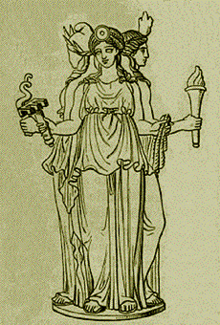
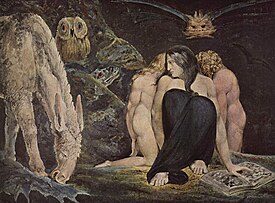

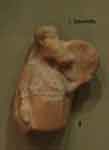
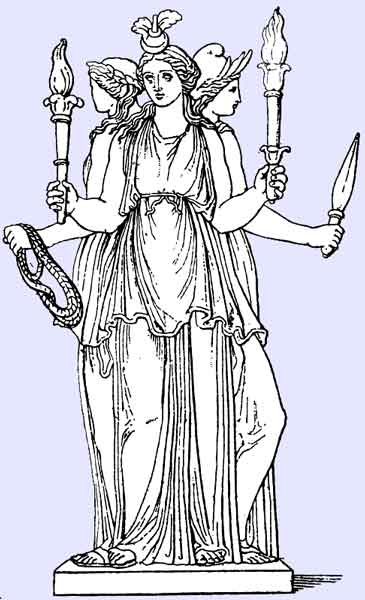
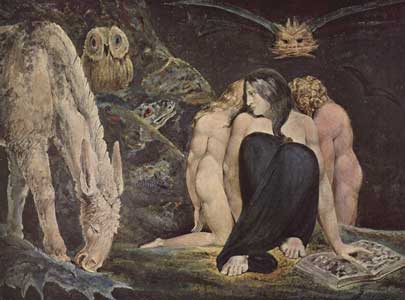
No comments:
Post a Comment